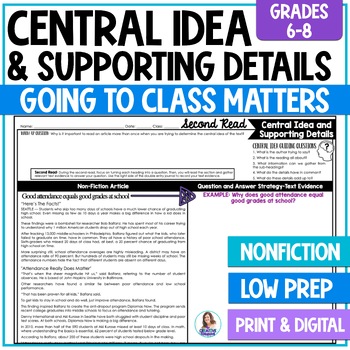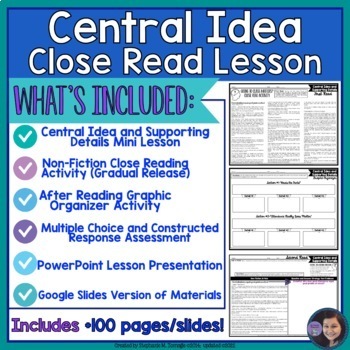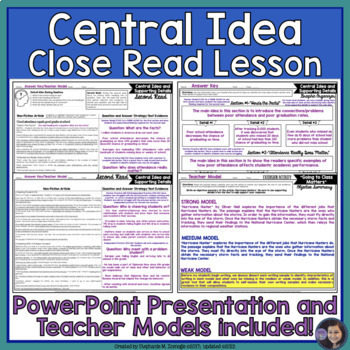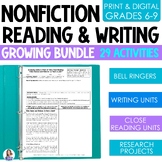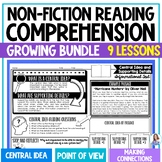Central Idea & Supporting Details - NonFiction Lesson - Main Idea Worksheets
- Zip
- Google Apps™

What educators are saying
Also included in
- This central idea and supporting details bundle includes 4 nonfiction reading comprehension lessons designed to help middle school ELA students determine the central idea in a nonfiction text. Each central idea or main idea lesson includes scaffolded close reading activities, main idea graphic orgaPrice $13.00Original Price $16.70Save $3.70
- Are you looking for a variety of middle school ELA nonfiction resources that contain engaging, rigorous, and differentiated materials? This non-fiction reading comprehension bundle contains 29 individual units and lessons, including close reading units, argumentative writing units, seasonal ELA bellPrice $89.99Original Price $136.88Save $46.89
- This nonfiction reading comprehension bundle contains 9 nonfiction lessons designed for middle school ELA students. Nonfiction text features and reading skills, like central idea and supporting details and author's purpose and point of view, can be difficult concepts for students to grasp. Each of tPrice $19.99Original Price $32.45Save $12.46
Description
This low-prep unit focuses on the central idea and supporting details of a nonfiction text. It includes a reading comprehension lesson designed for middle school ELA students to help them determine the central idea in a nonfiction text. This scaffolded lesson includes interactive close reading activities with a nonfiction reading passage and text-dependent questions. Both PRINT and DIGITAL materials are provided for the lesson, covering main ideas, supporting details, objective summaries, and nonfiction text features, among others.
Students will enjoy reading a nonfiction article that focuses on a relevant and high-interest topic: School Attendance - Does Going to Class Matter? Additionally, this challenging activity includes ideas for modifying and differentiating to meet the needs of all learners in your classroom. Student reading support tools include a two-column note organizer, modeling and opportunities for partner practice, and clear, step-by-step student instructions.
✅ Students will be required to show understanding of the following skills:
- Determine the central idea of a nonfiction article
- Identify key details from the article that support the central idea
- Determine the main idea of subsections in the article
- Identify textual evidence to support their responses
- Create an objective summary of the article (Extension Activity)
✍ What's Included:
1. Going to Class Matters!?! Central Idea and Supporting Details Lesson:
• Central Idea Mini Lesson
• Academic Vocabulary Activity
• Close Reading Activity with a Non-Fiction article
• Central Idea and Supporting Details Graphic Organizer
2. Going to Class Matters!?! Reading Comprehension Assessment
3. Objective Summary Extension Activity
4. PowerPoint Presentation
5. Answer Keys and Teacher Models
6. BONUS: Animal Testing Cold Read Assessment (PRINT and DIGITAL)
7. Central Idea, Objective Summary, and Nonfiction Text Features Anchor Charts
❤️ Why You'll Love This Resource:
✅ Comes in PRINT and DIGITAL Versions
✅ Teacher Guide with Clear Directions & Tips
✅ Scaffolded Strategies and Activities for ALL Learners
✅ Answer Keys and Students Work Samples
✅ LOW PREP Activities
✋ How Can You Use This Nonfiction Lesson?
- Whole Group Teaching
- Small Group Remediations
- Intervention Activities
- Learning Stations
- Test Prep
- Sub Plans
- Reading Comprehension Practice
What Other Teachers Are Saying About This Resource:
⭐⭐⭐⭐⭐: Ashley H. says, "This is a great article in general to use with students about the importance of attendance while also covering main idea and text evidence practice!"
⭐⭐⭐⭐⭐: Athena M. says, "I absolutely love everything about this resource - the graphics, the texts, the teaching ideas - such a fresh engaging way to teach main idea!"
⭐⭐⭐⭐⭐: Felicia S. says, "This is a very engaging task. The graphic organizers and Close Reading instructions were very meaningful and encouraged my students to read the text several times. Very good lesson!"
Created by Stephanie M. Icenogle, The Creative Classroom © 2014; updated ©2024
All rights reserved by author.
Permission to copy for single classroom use only.
Electronic distribution limited to single classroom use only.

